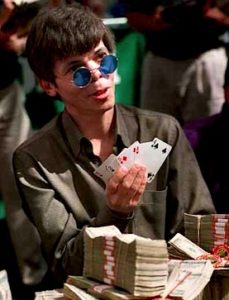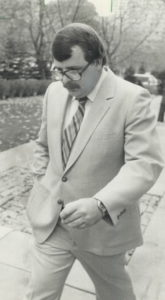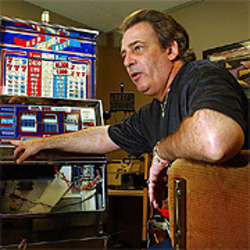 Stuart ‘Stu’ Ungar, otherwise known as ‘The Kid’ or, later, ‘The Comeback Kid’, won an estimated $30 million in his poker career, but died, almost penniless, in 1998. Nevertheless, Ungar is widely considered one of the finest exponents of Texas hold’em poker in history. He had the distinction of being one of just two players – the other being Johnny Moss – of winning the World Series of Poker (WSOP) Main Event three times. On the first occasion, in 1980, at the age of 26, he defeated Doyle ‘Texas Dolly’ Brunson to become, at the time, the youngest winner ever.
Stuart ‘Stu’ Ungar, otherwise known as ‘The Kid’ or, later, ‘The Comeback Kid’, won an estimated $30 million in his poker career, but died, almost penniless, in 1998. Nevertheless, Ungar is widely considered one of the finest exponents of Texas hold’em poker in history. He had the distinction of being one of just two players – the other being Johnny Moss – of winning the World Series of Poker (WSOP) Main Event three times. On the first occasion, in 1980, at the age of 26, he defeated Doyle ‘Texas Dolly’ Brunson to become, at the time, the youngest winner ever.
Born in New York City, to Jewish parents, in 1953, Ungar dropped out of high school in the tenth grade to focus on his burgeoning ‘career’ as a gin rummy player. Having made a name for himself in that sphere in his hometown, Ungar ultimately arrived in Las Vegas in 1977, but his continued success effectively forced him to switch his attention to poker. The WSOP Main Event in 1980 was just the second Texas hold’em poker tournament Ungar had entered, but not only did he win, but defended his title the following year.
Thereafter, Ungar was plagued by a cocaine addiction, which made his behaviour increasing erratic and, ultimately, led to his demise. Rocked by divorce in 1986 and the suicide of his teenage son, Richie, in 1989, Ungar was living in a refuge for homeless people when offered a loan of $10,000 by his old friend Billy Baxter to enter the WSOP Main Event in 1997. Miraculously, Ungar won again, splitting the £1 million first prize money with Baxter, but there would be no fairytale ending. Less than a year later, having wasted the money on drugs and gambling, Ungar was found dead, at the age of 45, in a budget motel on the outskirts of Las Vegas.
Stuart ‘Stu’ Ungar, otherwise known as ‘The Kid’ or, later, ‘The Comeback Kid’, won an estimated $30 million in his poker career, but died, almost penniless, in 1998. Nevertheless, Ungar is widely considered one of the finest exponents of Texas hold’em poker in history. He had the distinction of being one of just two players – the other being Johnny Moss – of winning the World Series of Poker (WSOP) Main Event three times. On the first occasion, in 1980, at the age of 26, he defeated Doyle ‘Texas Dolly’ Brunson to become, at the time, the youngest winner ever.
Born in New York City, to Jewish parents, in 1953, Ungar dropped out of high school in the tenth grade to focus on his burgeoning ‘career’ as a gin rummy player. Having made a name for himself in that sphere in his hometown, Ungar ultimately arrived in Las Vegas in 1977, but his continued success effectively forced him to switch his attention to poker. The WSOP Main Event in 1980 was just the second Texas hold’em poker tournament Ungar had entered, but not only did he win, but defended his title the following year.
Thereafter, Ungar was plagued by a cocaine addiction, which made his behaviour increasing erratic and, ultimately, led to his demise. Rocked by divorce in 1986 and the suicide of his teenage son, Richie, in 1989, Ungar was living in a refuge for homeless people when offered a loan of $10,000 by his old friend Billy Baxter to enter the WSOP Main Event in 1997. Miraculously, Ungar won again, splitting the £1 million first prize money with Baxter, but there would be no fairytale ending. Less than a year later, having wasted the money on drugs and gambling, Ungar was found dead, at the age of 45, in a budget motel on the outskirts of Las Vegas.
 Brian Molony is a self-confessed compulsive gambler, who was paroled in 1986 after serving a little over two years of a six-year prison sentence for embezzling millions of dollars from his former employer, Canadian Imperial Bank of Commerce. Formerly an assistant bank manager, Molony stole £10.2 million from the Toronto bank to fund gambling sprees in Atlantic City, New Jersey and Las Vegas, Nevada, where he bet, and almost invariably lost, millions of dollars at a time.
Brian Molony is a self-confessed compulsive gambler, who was paroled in 1986 after serving a little over two years of a six-year prison sentence for embezzling millions of dollars from his former employer, Canadian Imperial Bank of Commerce. Formerly an assistant bank manager, Molony stole £10.2 million from the Toronto bank to fund gambling sprees in Atlantic City, New Jersey and Las Vegas, Nevada, where he bet, and almost invariably lost, millions of dollars at a time. Dominic LoRiggio, otherwise known as ‘The Dominator’ and ‘The Man with the Golden Arm’, is a professional craps player, who claims to have perfected a method of ‘dice control’ which, if he is to be believed, transforms the apparently random act of rolling dice into something altogether more skilful. Allegedly, by holding and releasing dice in a certain way, a shooter can discourage spinning and rolling and thereby reduce the probability of throwing a seven from 16.67% to 16.05%; the advantage so gained is equivalent to that achieved by counting cards in blackjack.
Dominic LoRiggio, otherwise known as ‘The Dominator’ and ‘The Man with the Golden Arm’, is a professional craps player, who claims to have perfected a method of ‘dice control’ which, if he is to be believed, transforms the apparently random act of rolling dice into something altogether more skilful. Allegedly, by holding and releasing dice in a certain way, a shooter can discourage spinning and rolling and thereby reduce the probability of throwing a seven from 16.67% to 16.05%; the advantage so gained is equivalent to that achieved by counting cards in blackjack. At the time of writing, Philip ‘Phil’ Ivey is probably best known for the $10.2 million he still owes the Borgata Hotel and Casino, Atlantic City after being found guilty, along with partner, Cheung Yin ‘Kelly’ Sun, of cheating at baccarat in 2012. However, lawsuits aside, Ivey is widely considered the best all-round poker player in the world.
At the time of writing, Philip ‘Phil’ Ivey is probably best known for the $10.2 million he still owes the Borgata Hotel and Casino, Atlantic City after being found guilty, along with partner, Cheung Yin ‘Kelly’ Sun, of cheating at baccarat in 2012. However, lawsuits aside, Ivey is widely considered the best all-round poker player in the world. Stuart ‘Stu’ Ungar, otherwise known as ‘The Kid’ or, later, ‘The Comeback Kid’, won an estimated $30 million in his poker career, but died, almost penniless, in 1998. Nevertheless, Ungar is widely considered one of the finest exponents of Texas hold’em poker in history. He had the distinction of being one of just two players – the other being Johnny Moss – of winning the World Series of Poker (WSOP) Main Event three times. On the first occasion, in 1980, at the age of 26, he defeated Doyle ‘Texas Dolly’ Brunson to become, at the time, the youngest winner ever.
Stuart ‘Stu’ Ungar, otherwise known as ‘The Kid’ or, later, ‘The Comeback Kid’, won an estimated $30 million in his poker career, but died, almost penniless, in 1998. Nevertheless, Ungar is widely considered one of the finest exponents of Texas hold’em poker in history. He had the distinction of being one of just two players – the other being Johnny Moss – of winning the World Series of Poker (WSOP) Main Event three times. On the first occasion, in 1980, at the age of 26, he defeated Doyle ‘Texas Dolly’ Brunson to become, at the time, the youngest winner ever. Born in Tulsa, Oklahoma – where he also died, at the age of 68, in early 2019 – Tommy Glen Carmichael was a former television repair man, who discovered a knack for cheating slot machines when introduced to the so-called ‘top-bottom joint’ in 1980. He was first arrested for using the rudimentary cheating tool – which short-circuited older, electromechanical slot machines – in Las Vegas in 1985. He was sentenced to five years’ imprisonment, but served less than two. Thereafter he embarked on a career as an inventor of more sophisticated cheating devices, with which he would, ultimately, defraud casinos worldwide of thousands of dollars.
Born in Tulsa, Oklahoma – where he also died, at the age of 68, in early 2019 – Tommy Glen Carmichael was a former television repair man, who discovered a knack for cheating slot machines when introduced to the so-called ‘top-bottom joint’ in 1980. He was first arrested for using the rudimentary cheating tool – which short-circuited older, electromechanical slot machines – in Las Vegas in 1985. He was sentenced to five years’ imprisonment, but served less than two. Thereafter he embarked on a career as an inventor of more sophisticated cheating devices, with which he would, ultimately, defraud casinos worldwide of thousands of dollars.



